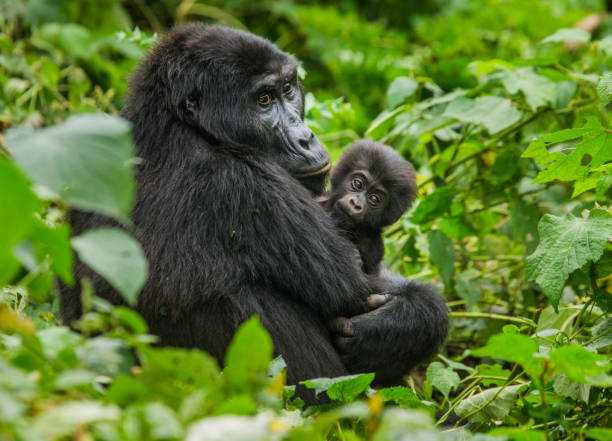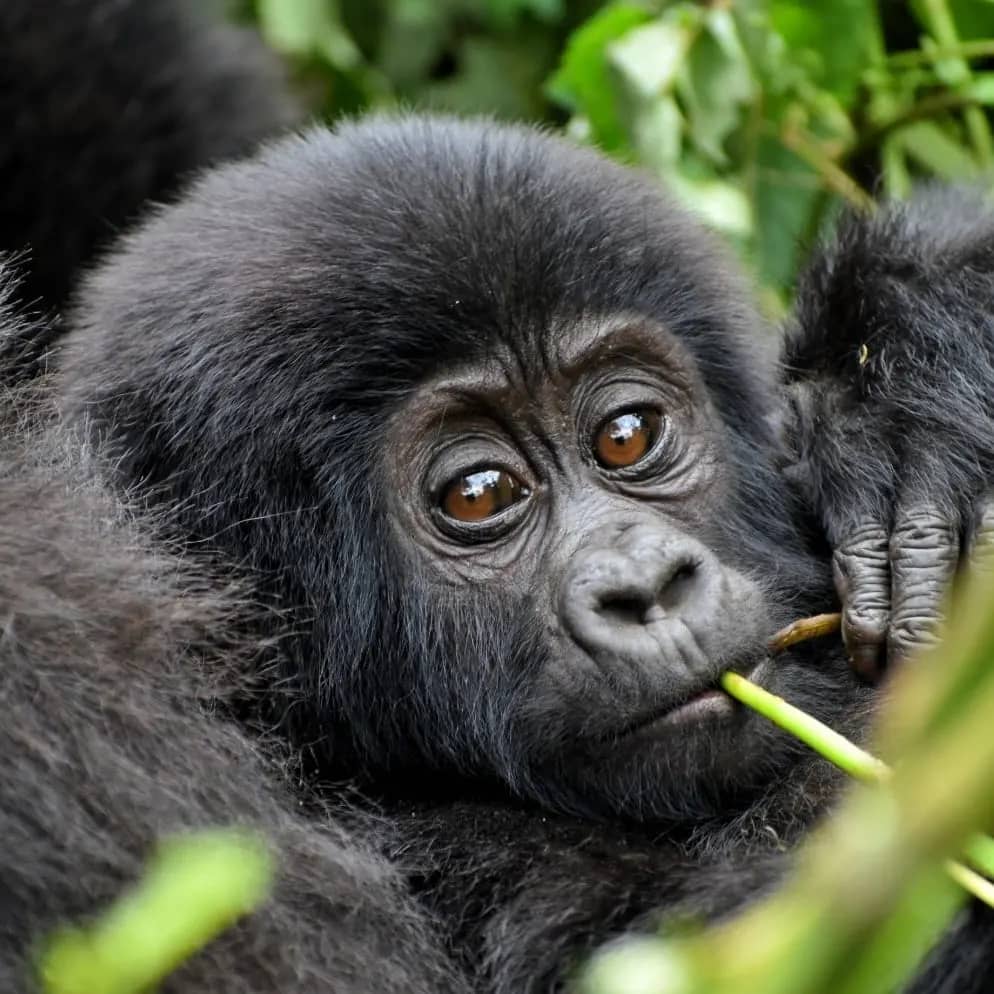All you need to know about Gorilla Trekking in Uganda and Rwanda
Here at Gorilla O’Clock we have tried to make this comprehensive info guide to gorilla trekking. We have decided to concentrate on Uganda and Rwanda, since these are the 2 places we send our clients to. This guide should be able to answer all the questions you have about the trek in Uganda and Rwanda. If there are questions you feel are not answered please don´t hesitate to contact us. We will be more than happy to answer any questions you might have. The questions below are clickable so you can easily jump to the relevant part of the page. Before we really begin lets answer what trekking gorillas really means.

What is Gorilla Trekking?
It is an experience that involves tracking habituated gorillas in the mountain forests of Rwanda, Uganda, and the Democratic Republic of Congo. Then you might ask the question what is gorilla habituation? It is the practice of training wild gorillas to be comfortable around humans. The park rangers are responsible for the training and it takes around 2-years to complete.
Like most wildlife, gorillas are territorial and protective of their families. They are gentle creatures, as long as they don’t view you as a threat. However, if you should come across an unhabituated gorilla, it could be very dangerous. This is why only habituated gorillas are tracked.
Habituated gorillas are very unlikely to view humans as a threat and will be passive during your visit. They tend to be curious as well, especially the young ones.
Mountain gorilla trekking is available in Uganda, Rwanda, and the Congo. There are safety concerns regarding the Democratic Republic of Congo. Thus, in this info guide, we only focus on Rwanda and Uganda which are also the two places that we send our clients.
In Rwanda, the mountain gorillas live in Volcanoes National Park. Gorillas in Uganda have two parks they call their home. Namely, Bwindi Impenetrable National Park and Mgahinga Gorilla National Park.
Questions to answer
Cost of the permits?
The gorilla trekking permits are 700$ USD per person in Uganda where 75% of the money raised is to conserve the gorilla population. Park entrance fees, gorilla watching for an hour, trackers and ranger fees are covered in the permits price too. In Rwanda the price is 1500$ USD per person and they sell out fast in both Uganda and Rwanda. There are only a limited amount of permits per day, so you have to secure your permits in good time before your trip. The price of the permit is included in all the packages we have where gorilla trekking is an activity.
When to go?
Gorilla trekking can be done all year around in Uganda and Rwanda. The best time to go gorilla trekking though is during the months of June, July, August, September and December. The reason for this is because there is less rain and the parks are drier, making it more simple to hike and see the gorillas. In Bwindi the average temperature throughout the year is 11°C/52°F in the morning and 23°C/73°F in the afternoon. So make a note of that when deciding what to wear considering it is quite cold in the morning. More on clothing later.
- January and February: Low season offering less crowds. Very little or no rain.
- March, April and May: Its rains a lot during these months. The gorilla trek will be the most challenging because of slippery slopes and visibility is not as good either.
- June, July & August: Peak season, its important to buy your permits early since they run out. This is the best time for gorilla safaris in Uganda and Rwanda.
What to expect?
Before the gorilla trekking starts there will be a safety briefing about the way you conduct yourself along the way and once you find the gorillas. You will be divided into groups of 8 people and then be assigned a Gorilla group to track.
The trek to find them can take anywhere from 1-4 hours because the gorillas move around. Once you find the group of gorillas you are assigned to the clock starts. You will have 1 hour with the gorillas.
The landscape of Bwindi Impenetrable (Uganda) is slightly different from that of Mgahinga (Uganda) and Volcanoes National Parks (Rwanda) but they are all located at higher elevations hence this makes them rainy, humid and cold especially in the nights. Truth is that while trekking you are not hiking on comfortable tracks, and sometimes there are no trails at all or you hike following very small trails.
How fit do I have to be?
While most gorilla treks can be completed by anyone with a basic level of fitness, a little preparation can be a good idea. If you don’t have any hiking experience it’s worth getting in some practice. Try to do some hillwalking before you go and ascend and descend steep uneven slopes carrying a backpack or equipment similar to what you would bring on the day of the adventure.
If you feel a little uneasy, that you have to carry a backpack etc.. while trekking, you can also hire porters to help carry your stuff and give you a helping hand going up and down the slopes. There is even an option to be carried, so yes basically it is for everyone, at least if you are willing to pay extra.
- The cost of a porter is about 20$ USD
- The cost of a sedan chair to be carried is 500$ USD
Will we definitely see the gorillas?
Well nature is unpredictable, so you can´t say that yes you will 100% see the gorillas. That being said, is it highly unlikely that you won´t see the gorillas. The answer to that is yes. There are rangers staying close to the different gorilla groups from early morning, who are in radio contact with trackers and rangers leading the group of people that you will be part of. So they guide you in the right direction.
What to wear?
- Wear Long Sleeved Shirts – Long Trousers
You need to wear a long sleeved shirt and Long trousers (can be either Khaki zip-up trousers or jeans) in fact if you can get waterproof trousers wear those. Both long trousers and long sleeved shirts protect you from branches, nettles, thorns or anything else that can prick/scratch you.
Cotton undergarments are recommended, also the ladies should ensure that they wear comfortable bras since the hike can be tough.
Some visitors ignore this advice and wear shorts and t-shirts, truth is by the end of the day the exposed skin has scratches, therefore ensure you follow this advice.
- Wear Waterproof Hiking Sturdy Boots
The hiking trails can be slippery especially when it rains therefore a pair of waterproof hiking boots is required. The shoes should be comfortable for you, in fact Rangers and Trekkers usually wear rubber boots or gumboots. Therefore you can’ see any one wearing white snickers, sandals or any inappropriate footwear.
Hiking boots will give you good stability, balance, traction and support to your ankles, with these also wear good and thick socks. It is important to tuck your trousers into your socks, this sounds and may look unfashionable but it will protect you against fire ants.
- Sturdy Gardening Gloves
This seems a joke, but it is right. These strong gardening gloves are going to be used in gorilla trekking not in gardening. They will help you support your selves on branches or vines, the gloves also give you protection against nettles such that you don’t get scratched.
You can put them off when you meet the Gorillas in order to take good photos.
- A Rain Jacket
Gorillasare trekked in the rainforest and usually in the morning hours, therefore rain might fall at any time whether it’s a dry season or not, and therefore rain jacket should come handy.
A poncho can also be worn, most trackers, rangers and porters wear it. If you are carrying one, carry a light one which you can easily fold and kip in your bag pack until you need it the next time.
- Wear a Hat
All you need is a good wide-brimmed hat on an expensive Tilley Hat, the hat protects your head and neck from rain or the sun. Onemight choose to wear a baseball cap but t will not protect your neck form the scotching sun after the mist in the mountains has disappeared.
Alternatively, if you don’t come with the hat from home, you could buy one form any local craft markets in the country where you will be trekking gorillas from.
By the end of the trek you will be glad that you wore your hat.
- Wear enough Insect Repellent
During the trek you come across different insects therefore wears a lot of insect repellent will protect you, also you can apply a sunblock cream on your exposed body parts.
For trackers who are on a Gorilla Habituation Experience, which takes a full days are advised to bring the repellent in their daypack.
- A Warm Sweater
Someone might wonder, a sweater in Africa? Yes, and it is important that you carry one or a cardigan to be worn in the early mornings and cool nights. It really gets so cold at night. In Mgahinga Gorilla Park or Volcanoes National Park, the temperature is at10°C/50°F and in Bwindi Impenetrable it’s at 11°C/52°F and sometimes it’s lower than this.
Therefore, this is why the luxury lodges here have fireplaces in cottages or rooms and other lodges give visitors hot water bottles for comfort throughout the cold night.
Gorilla Trekking Packing List
These items below are so important for usage during your safari in Uganda and Rwanda.
- Citronella soap: this is so important since it both acts as soap and an insect repellent; this type of soap is also anti-bacterial to the body.
- Insect repellent: The most frequent repellent that works on both mosquitoes and tsetse flies is RID. This can also be bought online and can be applied on with clothes.
- Sun Blocker cream: this cream will help you protect your face and eyes from the hot sun of Equatorial Uganda.
- Hand Wipes: these are handy items that help with preventing germs and can be bought here in Africa; they can help in situations where there is no water.
- Sun glasses: These help with protection from the direct sun shine.
- Malaria medicine: here consider the best tablets and malarone is always recommended as well as Doxycycline. These are considered effective on malaria treatments. This can be accompanied by a medicine bag containing all your medication to help you on your safari.
- A pack of toiletries: these can contain many items depending on the sex of the tourists.
- First Aid: this should be carried in case a tourist gets injured from the jungle.


